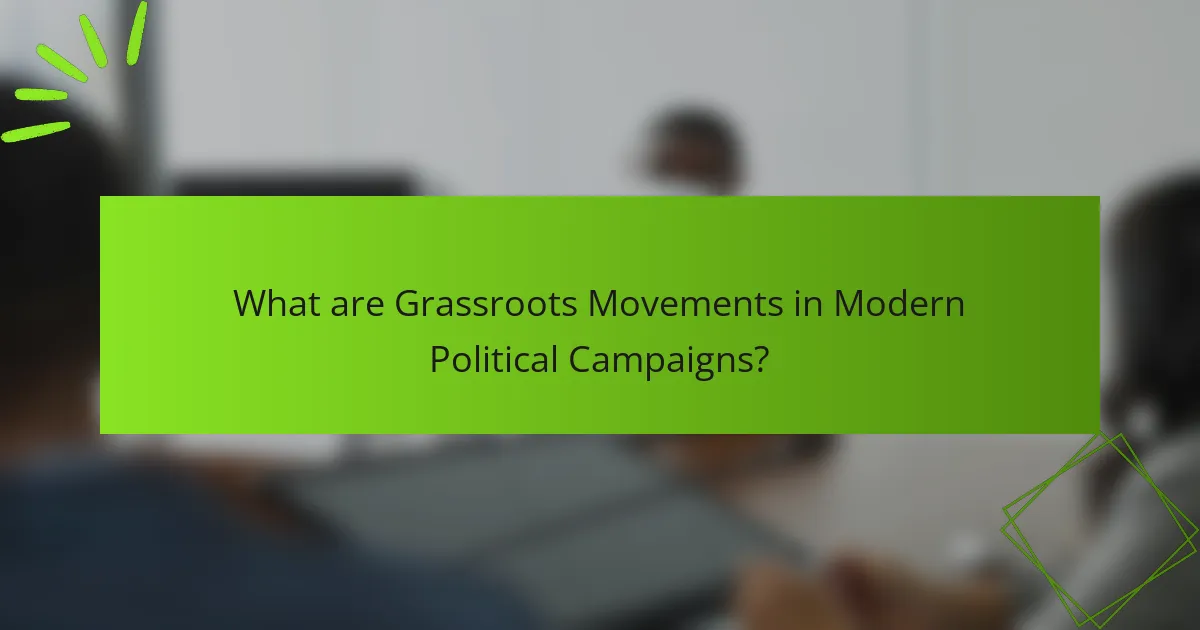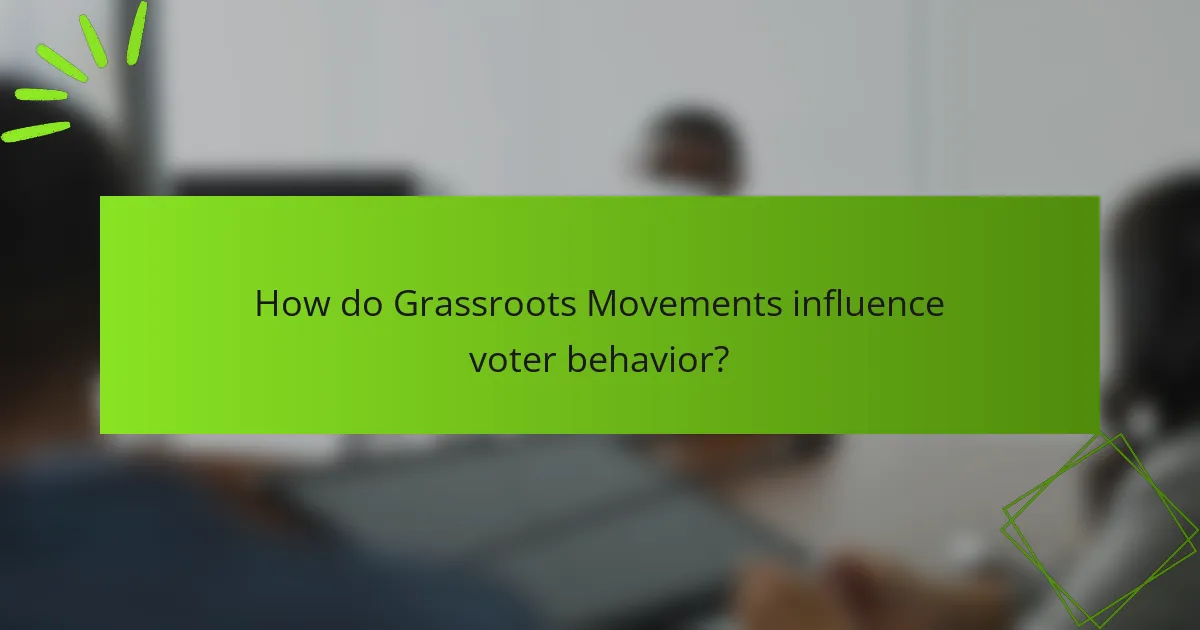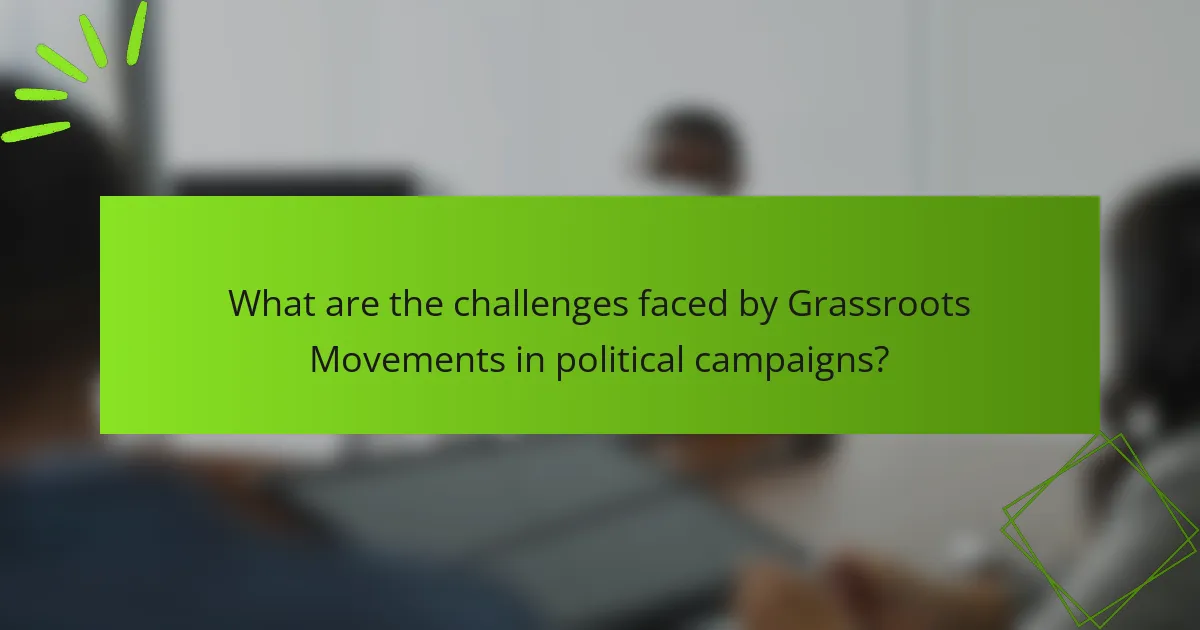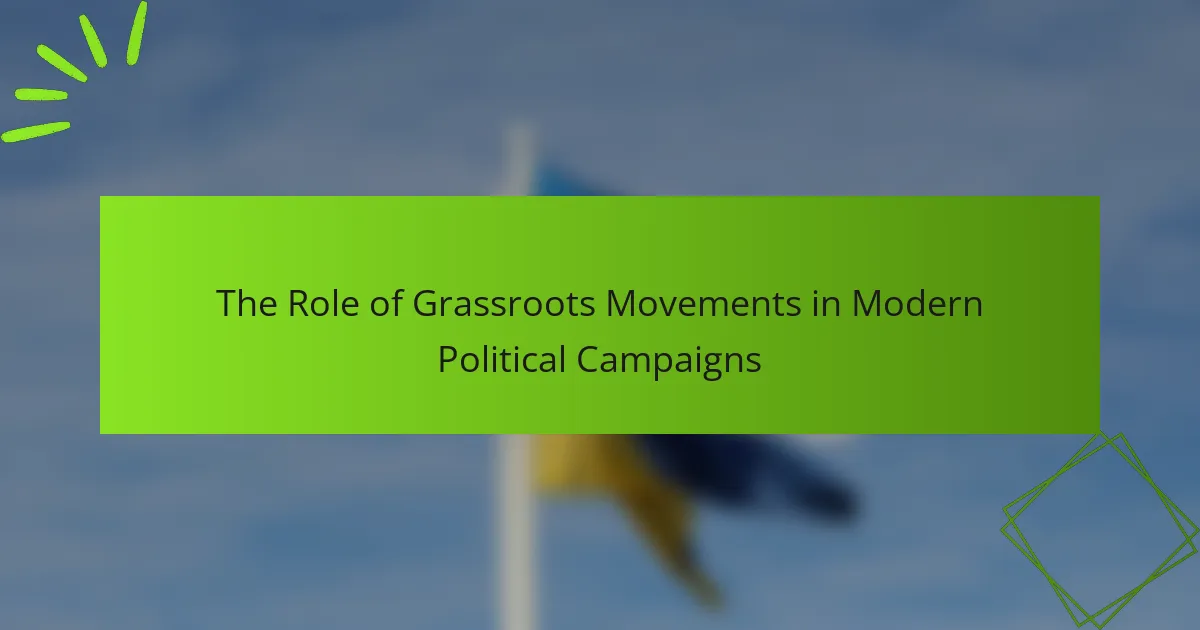Grassroots movements are organized efforts by ordinary citizens aimed at influencing political decisions and shaping electoral outcomes. These movements focus on local issues and employ strategies such as door-to-door canvassing, social media outreach, and public demonstrations to mobilize community support. Despite facing challenges like limited funding, lack of media coverage, and voter apathy, grassroots movements play a crucial role in increasing voter turnout and amplifying underrepresented voices. The rise of digital communication tools has further enhanced their ability to engage and empower citizens in the political process, as evidenced by successful campaigns like the 2008 Obama campaign. This article explores the significance, strategies, and challenges of grassroots movements in modern political campaigns.

What are Grassroots Movements in Modern Political Campaigns?
Grassroots movements in modern political campaigns are organized efforts by ordinary citizens to influence political decisions. These movements often arise from local communities and focus on issues relevant to those communities. They utilize strategies such as door-to-door canvassing, social media outreach, and public demonstrations. Grassroots movements aim to mobilize supporters and create a collective voice for change. They have gained prominence due to the rise of digital communication tools. For example, the 2008 Obama campaign effectively used grassroots mobilization to engage voters. This approach allows campaigns to build strong, community-based support networks. Grassroots movements can significantly impact election outcomes by increasing voter turnout and awareness.
How do Grassroots Movements differ from traditional political campaigns?
Grassroots movements differ from traditional political campaigns primarily in their structure and funding sources. Grassroots movements are typically community-driven and rely on local volunteers for mobilization. In contrast, traditional campaigns often depend on established political parties and significant financial contributions from donors. Grassroots efforts focus on building a broad base of support through personal connections and social networks. Traditional campaigns may prioritize media advertising and strategic messaging from professionals.
Research shows that grassroots movements can effectively engage citizens and foster civic participation. A study by the Harvard Kennedy School found that grassroots campaigns can increase voter turnout by mobilizing individuals who feel disconnected from the political process. This highlights the unique ability of grassroots movements to create a sense of ownership among participants.
What characteristics define Grassroots Movements?
Grassroots movements are defined by their community-driven nature and local organization. They typically emerge from the collective efforts of individuals at the local level. These movements prioritize participation and mobilization of ordinary citizens. They often focus on social issues, advocating for change from the bottom up. Grassroots movements rely on volunteer efforts and community engagement rather than top-down leadership. They utilize social media and digital platforms to organize and spread their message. Historical examples include the Civil Rights Movement and environmental campaigns. These movements demonstrate the power of collective action in influencing policy and societal change.
Why are Grassroots Movements important in contemporary politics?
Grassroots movements are important in contemporary politics because they empower ordinary citizens to influence political change. These movements mobilize community engagement and raise awareness on critical issues. They often challenge established power structures and advocate for marginalized voices. Grassroots movements can effectively organize campaigns that resonate with local communities. Historical examples include the Civil Rights Movement and recent climate action initiatives. Research shows that grassroots efforts can lead to significant electoral outcomes, as seen in the 2018 midterm elections in the U.S. These movements also foster a sense of community and collective action, enhancing democratic participation.
What strategies do Grassroots Movements employ in political campaigns?
Grassroots movements employ several strategies in political campaigns. They focus on community engagement to mobilize local support. This involves organizing events and rallies to raise awareness. They utilize social media for outreach and to amplify their message. Grassroots movements often engage in door-to-door canvassing to connect with voters personally. They build coalitions with other organizations to strengthen their impact. Fundraising is conducted through small donations to maintain independence from large donors. These strategies have been effective; for example, the 2008 Obama campaign utilized grassroots tactics to mobilize millions of volunteers.
How do Grassroots Movements utilize social media for mobilization?
Grassroots movements utilize social media for mobilization by creating awareness and engaging supporters. They share information rapidly across platforms like Facebook and Twitter. This allows them to reach a wide audience quickly. Social media facilitates real-time communication and coordination among members. Grassroots organizations often use hashtags to unify messages and increase visibility. Campaigns can mobilize supporters for events through social media invitations. According to a 2020 study by the Pew Research Center, 69% of Americans use social media, making it an effective tool for outreach. Additionally, successful movements like Black Lives Matter demonstrate the power of social media in organizing protests and spreading messages.
What role do community engagement and local organizing play?
Community engagement and local organizing are crucial for grassroots movements in political campaigns. They foster relationships between candidates and constituents. This connection encourages voter participation and mobilization. Local organizing helps identify community issues and priorities. It empowers residents to voice their concerns and influence decision-making. Studies show that engaged communities have higher voter turnout rates. For instance, the 2020 election saw increased participation in areas with strong local organizing efforts. This demonstrates the effectiveness of grassroots strategies in shaping political landscapes.

How do Grassroots Movements influence voter behavior?
Grassroots movements significantly influence voter behavior by mobilizing communities and raising awareness on specific issues. These movements often engage citizens at the local level, fostering a sense of ownership and empowerment. They utilize social media to spread their messages quickly, reaching a broader audience. Research indicates that grassroots campaigns can increase voter turnout by creating personal connections among community members. For instance, a study by the Pew Research Center found that grassroots efforts can lead to a 10-20% increase in participation during elections. Additionally, these movements often highlight underrepresented voices, encouraging marginalized groups to engage politically. By addressing local concerns, grassroots movements create a direct link between voters and the political process, ultimately shaping electoral outcomes.
What impact do Grassroots Movements have on voter turnout?
Grassroots movements significantly increase voter turnout. They mobilize communities by fostering local engagement and activism. Research shows that grassroots efforts can lead to higher participation rates in elections. For example, a study by the Harvard Kennedy School found that grassroots campaigns can boost turnout by 10-20%. These movements often utilize door-to-door canvassing, phone banking, and social media outreach. This direct engagement helps educate voters about issues and candidates. Additionally, grassroots movements empower marginalized groups, increasing their representation in the electoral process. Overall, their impact on voter turnout is both measurable and substantial.
How do Grassroots Movements educate voters about issues?
Grassroots movements educate voters about issues through community engagement and direct outreach. They organize events such as town halls and workshops to discuss specific topics. These movements utilize social media platforms to disseminate information quickly. They create informative materials like pamphlets and videos that simplify complex issues. Volunteers often canvass neighborhoods to share knowledge and encourage discussions. Research shows that face-to-face interactions significantly enhance voter understanding. According to a study by the Pew Research Center, personal engagement increases civic participation. Grassroots movements leverage local networks to amplify their message effectively.
Why do Grassroots Movements resonate with younger voters?
Grassroots movements resonate with younger voters because they emphasize community engagement and social justice. Younger voters are often motivated by issues that directly affect their lives. These movements provide a platform for their voices and concerns. They foster a sense of belonging and empowerment among participants. Research indicates that 70% of millennials prefer to engage in grassroots activism. This engagement allows them to influence change on issues like climate change and education. Grassroots movements also utilize social media effectively, reaching younger audiences where they are most active. This digital outreach enhances their visibility and impact.
In what ways do Grassroots Movements shape political discourse?
Grassroots movements shape political discourse by mobilizing community engagement and influencing public opinion. They provide a platform for marginalized voices, ensuring diverse perspectives are heard. Through social media and local organizing, these movements amplify their messages rapidly. Historical examples include the Civil Rights Movement, which shifted national dialogue on race and equality. Grassroots efforts often lead to policy changes, as seen with environmental advocacy influencing climate legislation. They challenge traditional political structures, fostering a more participatory democracy. Recent studies show that grassroots campaigns significantly impact voter turnout and awareness.
How do Grassroots Movements bring attention to underrepresented issues?
Grassroots movements bring attention to underrepresented issues by mobilizing community members around specific causes. They often utilize social media to amplify their messages. This allows them to reach a wider audience quickly. Grassroots organizations frequently hold local events to raise awareness. These events can include rallies, workshops, and community meetings. They also collaborate with local leaders to gain credibility. Research shows that grassroots movements can influence public policy by demonstrating community support. For example, the Black Lives Matter movement has brought significant attention to racial injustice issues.
What role do narratives play in the success of Grassroots Movements?
Narratives play a crucial role in the success of grassroots movements. They help to shape public perception and mobilize supporters. Effective narratives resonate emotionally with individuals. They create a sense of belonging and shared purpose. For example, the narrative of social justice in the Civil Rights Movement inspired widespread participation. Research shows that compelling stories can increase engagement and drive action. A study by the Stanford Social Innovation Review highlights the importance of narrative in fostering community connections. Overall, narratives serve as a powerful tool for grassroots movements to communicate their goals and inspire change.

What are the challenges faced by Grassroots Movements in political campaigns?
Grassroots movements face several challenges in political campaigns. Limited funding restricts their ability to compete with larger organizations. Lack of media coverage often leads to reduced visibility for their causes. Organizational capacity can be insufficient, hindering effective mobilization and outreach. Fragmentation within movements can create disunity and dilute messaging. Regulatory hurdles may complicate fundraising and campaign activities. Additionally, voter apathy can undermine their efforts to engage communities. These challenges can significantly impact the effectiveness of grassroots movements in achieving political goals.
What obstacles do Grassroots Movements encounter in funding?
Grassroots movements encounter several obstacles in funding. Limited access to traditional funding sources is a primary challenge. Many grassroots organizations lack established networks that connect them to large donors. Additionally, they often face competition for funds from larger, more recognized organizations. This can make it difficult to secure necessary financial support. Furthermore, grassroots movements may struggle with regulatory barriers related to fundraising. These barriers can complicate their efforts to raise money. Lastly, public perception can impact funding opportunities. If a movement is viewed as controversial, potential donors may hesitate to contribute.
How do Grassroots Movements navigate political opposition?
Grassroots movements navigate political opposition through strategic organization and community engagement. They build coalitions to amplify their voice and increase influence. Mobilizing local support is crucial for demonstrating widespread backing. Effective communication helps to counter misinformation and misrepresentation. Grassroots movements often utilize social media to spread their message rapidly. They engage in peaceful protests to draw attention to their cause. Legal strategies, such as lobbying and litigation, may also be employed to challenge opposition. Historical examples include the Civil Rights Movement, which effectively mobilized grassroots support against systemic racism.
What are the implications of internal conflicts within Grassroots Movements?
Internal conflicts within grassroots movements can lead to fragmentation and reduced effectiveness. These conflicts often result in divergent goals among members. This disunity can weaken the movement’s overall impact on political campaigns. Research indicates that lack of cohesion diminishes public support and engagement. For instance, a study by the Harvard Kennedy School found that internal strife can undermine mobilization efforts. Additionally, conflicting messages can confuse potential supporters. This confusion may lead to a loss of credibility in the political arena. Ultimately, internal conflicts can stall progress and hinder the movement’s ability to influence policy change.
How can Grassroots Movements effectively sustain their momentum?
Grassroots movements can effectively sustain their momentum by fostering community engagement and maintaining clear communication. Regularly organizing events keeps participants involved and motivated. Utilizing social media platforms allows for consistent updates and outreach. Building partnerships with local organizations can expand resources and support. Providing training and resources empowers members to take initiative. Celebrating small wins reinforces progress and encourages continued participation. Regular assessments of goals help adjust strategies as needed. This approach has been observed in successful movements like the Women’s March, which maintained momentum through ongoing activism and community building.
What best practices can Grassroots Movements adopt for long-term success?
Grassroots movements can adopt several best practices for long-term success. First, they should build a strong community foundation. Engaging local supporters fosters loyalty and commitment. Second, establishing clear goals is essential. Specific objectives guide efforts and measure progress. Third, effective communication strategies are crucial. Utilizing social media and local events enhances outreach. Fourth, forming coalitions with like-minded organizations amplifies impact. Collaborating increases resources and broadens influence. Fifth, training volunteers is vital. Equipped supporters can better advocate for the cause. Sixth, adapting to feedback ensures relevance. Listening to community needs strengthens connections. Finally, celebrating small victories maintains motivation. Recognizing achievements encourages continued participation. These practices help grassroots movements sustain momentum and achieve their objectives.
How can Grassroots Movements build coalitions with other organizations?
Grassroots movements can build coalitions with other organizations by establishing common goals. They should identify shared interests and values with potential partners. Clear communication is essential for fostering collaboration. Regular meetings can help maintain alignment and build trust among organizations.
Additionally, grassroots movements can leverage social media to reach a wider audience and attract support. Engaging in joint campaigns can amplify their message and increase visibility. Sharing resources and expertise can strengthen the coalition’s impact. Successful examples include the Civil Rights Movement, which united various groups to achieve legislative changes.
What practical tips can be applied by emerging Grassroots Movements?
Emerging grassroots movements can enhance their effectiveness by focusing on community engagement, clear messaging, and strategic partnerships. Community engagement builds trust and fosters participation. Organizing local events can promote awareness and inspire action. Clear messaging is essential for conveying the movement’s goals. Using simple, relatable language helps resonate with a broader audience. Strategic partnerships with local organizations can amplify reach and resources. Collaborating with established groups can provide credibility and support. Utilizing social media platforms is vital for outreach. Engaging followers through regular updates can maintain momentum. Lastly, measuring impact through feedback and data can guide future actions. This approach ensures adaptability and sustained growth.
Grassroots movements are community-driven efforts by ordinary citizens aimed at influencing political decisions and fostering civic participation. This article explores the characteristics, strategies, and significance of grassroots movements in modern political campaigns, highlighting their differences from traditional campaigns, the impact on voter behavior, and the challenges they face. Key topics include the role of social media in mobilization, the importance of community engagement, and best practices for sustaining momentum and building coalitions. Additionally, the article addresses how grassroots movements educate voters and resonate with younger demographics, ultimately shaping political discourse and electoral outcomes.
